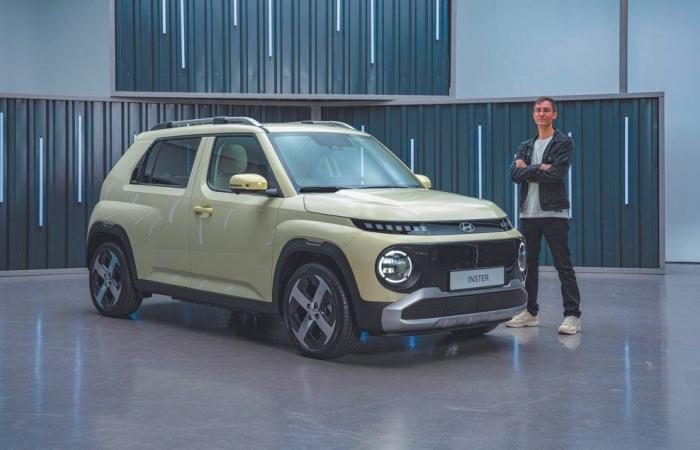The debate is not new: should Asian manufacturers bring their kei-cars, these cars limited in size and power to benefit from advantageous taxation, to the European continent? Suzuki and Daihatsu have already done it in the past with the Wagon R and Copen, and today Hyundai is doing it with the Inster. If its look is not completely foreign to you, perhaps you have already seen our article on the Casper. The Inster is in fact the international version of the Casper (the latter remains confined to South Korea), but it stands out with more generous proportions. From 3.60 m, the total length thus increases to 3.83 m, which remains ultra compact despite everything. And with 1.61 m high and wideno problem parking it even in the tightest parking lots.
The almost symmetrical side between the front and the rear, with optics which mix the “pixel” LEDs, as on the Ioniq electric models, and large round projectors, gives a side immediately sympathetic to Inster, who can also count on curves to soften their silhouette. For their part, the rims range from 15 to 17 inches. But the Inster’s real asset lies in the cabin.
Foolproof modularity
We often regret minivans for their practical modularity and the possibility of reconfiguring the interior according to one’s needs. At Hyundai, the engineers understood this well; they pulled out all the stops to maximize interior space. With a wheelbase of 2.58 m, which is enormous for such a small car, the Inster offers unsuspected ease to passengers, both front and rear. Especially since those in rank two benefit from a bench that slides 16 cm, allowing you to provide leg space that will suit even the largest people!
Conversely, it is also a good way to convey the trunk from 238 to 351 dm3 when you want to transport objects rather than people. And this is where Korean makes the difference, since it is possible to fold down the backrests of all seats in order to form an almost flat loading floor! Yes, even the driver, if it occurred to you to sleep in your car with an inflatable mattress. Or go find a shelf at Ikea. Or even load a surfboard. In short, you will have understood, it is flexibility and space on board that take precedence, which immediately gives a great advantage to the Inster compared to other mini-city cars, which are less and less numerous. For this preview, Hyundai made us available a version with two independent seats at the rear, but a 5-seater version will also be produced, although it is not yet known which one will be sold in France, or if the two will coexist.
All of a great
Unsurprisingly for the segment, the cabin is almost exclusively made of hard plastic. However, the whole does not look poor and everything is correctly assembled. We won’t dwell on the details here, since the pre-production model that we discovered was not built to the standards of the customer cars that will be produced later in the year. What we can say, however, is that the equipment is plethoric. For example, we find two 10.25-inch screens as standard (one for the meters, the other, touchscreen for infotainment) or automatic air conditioning, and the high finish has the same equipment as cars in the higher segment: 360° camera, induction charger, heated seats and steering wheel, sunroof etc. We wonder how Hyundai managed to fit so much functionality into such a small car! As for the presentation of the dashboard, it is reminiscent of that of an Ioniq 5, in reduction.
Two electric motors, but at what price?
The Hyundai Inster will initially be offered only in electric form. There will be two sizes of batteries to choose from, 42 and 49 kWh, with powers of 97 and 115 hp respectively. Enough to allow the brand to move forward 300 and 350 km of autonomy approximately, figures which will be refined when approval has taken place, and which we will of course not fail to verify on our test bench. It now remains to know the prices, which the manufacturer is keeping well under wraps for the moment. It must be said that marketing will not take place before the end of the year, with first customer deliveries expected at best in December, or even January 2025.
The real pleasant surprise would be that the base price remains contained and does not exceed €21,000 or €22,000. As a reminder, a Dacia Spring, less powerful, with less autonomy and also much more basic, costs from €18,900 before bonus. As for the high version, a price around €26,000 would be justified if the promise of autonomy is there. But nothing is less certain with Hyundai, which has recently been more inclined to increase its prices than to lower them.
Compare the real ranges of the best electric cars according to our standardized measurement cycle. Battery capacity, consumption, autonomy, we tell you everything!






